이유식과 이유식을 잘 먹이는 방법, Solid food and How to feed the solid foods
- 신생아들에게 모유나 인공영양을 먹이는 것은 마치 한 폭의 그림을 그리는 것과 같이 일률적으로 정해서 줄 수 없다. 하나하나가 의학적 예술이고 식이의술이다. 영아들에게 이유식을 먹이는 것도 그러하다. 이유식을 영아들에게 먹이는 방법은 일률적으로 정해줄 수 없다.
- 다음에 있는 정보는 이유식을 먹일 때 참고가 될 수 있다.
1. 이유식의 종류에 따른 이유 방법
- 생후 4개월 이후 추력 반사가 없어진다.
- 생후 4개월 이후의 영아들에게 이유식을 처음으로 줄 때는 짠 모유나 인공영양에 이유식을 섞어 수저로 떠먹이는 것이 좋다.
- 만일 영아가 이유식을 잘 받아먹고 소화를 잘 시키면 그 때부터 이유식을 주기 시작해도 된다.
- 가장 먼저 시험 삼아 먹일 수 있는 이유식은 시리얼 류 이유식, 즉 쌀로 만든 곡물류(곡분류) 이유식이다.
- 쌀로 만든 시리얼류 이유식에서 영아들이 필요로 하는 에너지와 영양분, 비타민, 철분, 등 미네랄을 충분히 공급받을 수 있다.
- 특히 이미 요리된 영아용 쌀 시리얼류 이유식 성분 속에는 글루틴(Gluten)성분이 들어 있지 않아 또한 좋은 이유식 중 하나로 꼽힌다.
- 처음에는 쌀로 만든 시리얼류 이유식의 한 수저(5~15g)를 짠 모유나 인공영양, 또는 물에 개어 하루에 1~3회 먹여 본다.
- 이런 쌀로 만든 시리얼류 이유식을 하루 1~4번, 3~7일간 시험 삼아 먹여 본다.
- 그 이유식을 잘 먹는지, 그 이유식을 먹은 후 소화를 잘 시킬 수 있는지, 방귀를 많이 뀌지 않는지, 설사나 변비 등 위장장애가 생기지는 않는지 관찰한다. 쌀로 만든 이유식을 먹고 어떤 부작용이 생기는지 조심히 관찰해본 결과, 아무 문제가 생기지 않고 아기도 그 이유식을 먹기 좋아하면 그 이유식의 양을 점차로 서서히 늘려 먹인다.
- 그 다음 당근, 시금치, 호박 등으로 요리한 채소류 이유식이나 바나나, 사과 등으로 만든 과일류 이유식들 중 한 가지를 골라 먹여본다.
- 단, 과일류 이유식이나 채소류 이유식은 될 수 있는 한 생후 6개월 이전 영아들에게는 먹이지 않는다.
- 과일류 주스나 채소류 주스의 이유식은 생후 6개월 이전에 먹이지 않고 그 후 영아들에게도 될 수 있는 한 많이 먹이지 않는다.
- 다음으로 퓌레 채소류 이유식, 퓌레 과일류 이유식, 퓌레 육류 이유식 중 한 가지 이유식을 먹이기 시작한다.
- 그리고 곡물류 시리얼 이유식과 과일류 이유식이든 혼합 이유식을 먹여본다. 이때부터 티징(Teething) 비스킷도 먹일 수 있다.(사진 5-73, 5-74 참조)
- 그 다음 곡물류 이유식, 채소류 이유식, 과일류 이유식, 고기류 이유식 등 여러 가지의 이유식들 중 한 가지, 두 가지 또는 세 가지 이유식을 동시 먹여볼 수 있다.
- 쇠고기, 양고기, 닭고기 등의 육류 이유식이나 생선류, 고기류 이유식은 생후 9~10개월부터 한 가지씩 조금씩 시험 삼아 먹여 보고, 영아가 먹기 좋아하고 소화를 잘 시키면 의사의 지시에 따라 계속 먹인다.
- 육류 이유식이나 생선류 이유식도 시리얼류 이유식을 먹일 때와 같은 요령껏 먹인다.
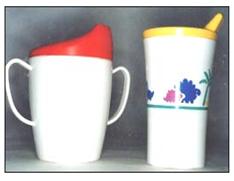
사진 4-115. 이유식을 먹일 때 쓸 수 있는 연습용 컵
Copyright ⓒ 2011 John Sangwon Lee, MD, FAAP

사진 4-116.나이에 따라 아기 이유식 과자도 손으로 먹도록 줄 수 있다.
Copyright ⓒ 2011 John Sangwon Lee, MD, FAAP
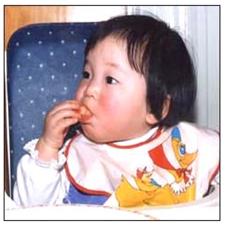
사진 4-117. 나이에 따라 아기 이유식 과자도 혼자서 손으로 붙들고 먹도록 줄 수 있다.
Copyright ⓒ 2011 John Sangwon Lee, MD, FAAP
2. 아기의 나이(월령)에 따른 이유 방법
- 생후 6~8개월 된 영아들에게 고형 이유식을 처음 먹이기 시작하면 처음 얼마 동안은 하루 세 번 모유를 수유 한 후 바로 시험 삼아 고형 이유식을 한두 테이블스푼 정도 먹여볼 수 있다.
- 어떤 영아들은 하루에 거의 반 컵 이유식을 먹기도 한다. 그러나 이때도 대부분의 영아들에게는 모유가 그날의 주 에너지 자원이 되고 영양분이 된다.
- 영아가 이유식을 점점 더 많이 먹을수록 하루에 먹는 젖의 양이나 횟수도 점점 줄어든다. 심지어 수유모의 유방 크기도 줄어들 수 있다.
- 생후 8~10개월 된 영아들의 대부분은 밥상 음식물을 먹기를 좋아한다. 이 나이의 영아들에게는 모유 이외 하루 3~4회씩 이유식을 먹이고 육류 이유식, 닭고기 이유식, 두류 이유식, 치즈 이유식, 두부 이유식, 피넛 버터 이유식 등 고 단백질 류 이유식도 먹일 수 있다.
- 곡물류 이유식을 하루 2~3번, 한 번에 반 컵 정도 먹이고 쌀밥이나 쌀죽 또는 빵을 먹일 수 있다.
- 그리고 과일류 이유식이나 채소류 이유식을 한번에 5~30cc 하루에 4번씩 먹일 수 있다.
- 과일 주스류 이유식은 90cc 정도 하루 한 번 먹인다.
- 육류, 닭고기, 생선, 치즈, 두류, 또는 피넛버터 등이 든 고 단백질류 이유식은 하루 한 번 정도 먹인다.
- 생후 9개월 이후부터 달걀노른자는 1주에 3~4번 먹인다.
- 고형 이유식을 잘 먹으면 이때부터 고형 이유식을 먼저 먹이고 모유수유는 나중에 해도 된다.
- 이 시기 영아들은 엄마의 젖을 먹어서 에너지나 영양분을 얻기 위해서보다, 정신적 안정감을 얻기 위해서, 엄마의 사랑을 받기 위해서 수시로 모유를 먹는 아기들도 있다.
- 생후 10~12개월 된 영아는 밥상의 음식물을 제법 잘 먹는다.
- 일반적으로 첫 돌까지 전 우유(Whole milk)를 먹이지 말라고 권장하지만, 첫 돌 이후 모유를 거의 먹지 않거나 아주 안 먹는 영유아들에게는 전 우유를 먹이기 시작할 수 있다.
- 저지방 탈지우유나 전지분유(Evaporated milk)는 먹이지 않는 것이 좋다.
- 만일 영아가 우유에 알레르기가 있으면 콩단백질로 만든 인공영양이나 저 알레르기성 인공영양을 먹인다. 그러나 그것에도 알레르기가 생길 수 있으므로 주의해야한다.
- 치즈나 두부는 칼슘이 많이 들어 있어서 영아에게 먹이기에 좋은 음식물이다.
- 이 시기에 낮잠을 재울 때 아기를 편안하고 행복하게 사랑 해주고, 아침 점심을 먹인 후 모유수유를 할 수 있다.
- 고형 이유식의 섭취량이 점점 더 늘고, 밥상 음식물을 먹기 시작하고, 모유수유의 횟수와 양이 자연적으로 점점 줄어들면서 엄마의 젖을 더 이상 먹지 않아도 잘 성장하고 있다고 판단되면 젖을 완전히 떼든지, 모유수유도 하고 인공영양을 필요에 따라 먹일 수 있는 일부 이유를 할 수 있다.
- 고형 이유식을 처음 먹일 때는 꼭 한 종류의 고형 이유식을 시험 삼아 1주일 정도 먹여본다. 그 고형 음식물을 먹고 위장 장애, 알레르기 등 문제가 없으면 그 다음부터 두세 가지 고형 이유식을 섞은 종합 이유식을 먹여도 된다.
- 영아들이 그 두 가지의 고형 이유식을 먹고 소화를 잘 시키면 그 고형 이유식을 하루 1~4번 먹여도 된다. 성장 속도와 체중 증가에 따라 고형 이유식의 양도 점차로 증가시킨다.
- 한 번에 먹일 수 있는 고형 이유식의 양은 영아가 먹는 모유의 양이나 인공영양의 양, 영아의 식성 등에 따라 다르다.
- 그러나 고형 이유식은 한꺼번에 너무 많이 먹이는 것보다 조금씩 먹이기 시작해서 점차 더 많이 먹이는 것이 더 좋다. 즉, 고형 이유식은 처음부터 많이 먹이는 것보다 소량 먹이기 시작해서 점차 그 양을 증가시키는 것이 훨씬 낫다.
- 주스류 고형 이유식을 처음 줄 때는 한 번에 한 종류의 주스를 15~30cc 먹여본다.
- 시리얼류 고형 이유식이나 육류 이유식을 처음으로 줄 때는 한 테이블스푼(15㏄) 정도를 줘본다.
- 고형 이유식을 주는 타이밍은 엄마가 결정할 수 있다. 모유나 인공영양을 먹인 직후 고형 이유식을 주든지, 모유나 인공영양을 먹일 시간에 고형 이유식만 주든지, 모유나 인공영양을 먹이기 바로 전에 고형 이유식을 먹이든지, 모유나 인공영양을 먹을 시간 사이사이에 줄 수 있다.
- 생후 6~8개월 이전 영아들에게는 모유나 인공영양을 먼저 먹인 후 고형 이유식을 나중에 먹여도 된다. 반면, 6~8개월 이후의 영아들에게 고형 이유식을 줄 때는 모유나 인공영양을 먹이기 직전이나 직후 고형 이유식을 주고, 하루 1~4회 먹일 수 있다.
- 이 두 가지의 고형 이유식 먹이는 방법 중 한 가지를 택하거나 두 가지 방법을 절충해서 먹여도 된다.
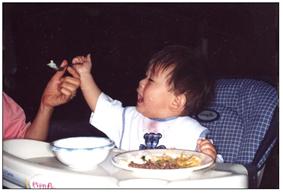
사진 4-118. 생후 10개월 이내에 식구들이 먹는 밥상 음식물을 잘 먹는 영아도 많다.
Copyright ⓒ 2011 John Sangwon Lee, MD, FAAP
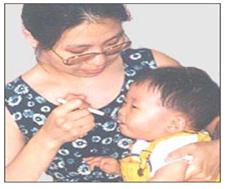
사진 4-119. 고형 이유식을 먹일 때는 폭신하게 안고 사랑하면서 수저로 먹인다.
Copyright ⓒ 2011 John Sangwon Lee, MD, FAAP
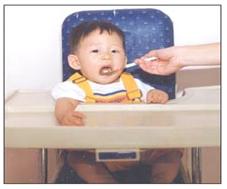
사진 4-120. 고형 이유식을 수저로 먹인다. Copyright ⓒ 2011 John Sangwon Lee, MD, FAAP
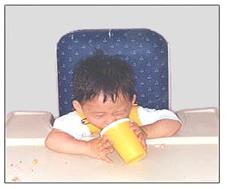
사진 4-121. 액체 이유식의 종류에 따라 컵과 수저로 먹인다.
Copyright ⓒ 2011 John Sangwon Lee, MD, FAAP
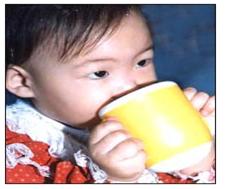
사진 4-122. 액체 이유식은 컵이나 수저로 먹인다.
Copyright ⓒ 2011 John Sangwon Lee, MD, FAAP
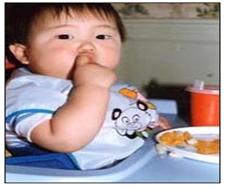
사진 4-123. 이유식을 손으로 먹도록 한다.
Copyright ⓒ 2011 John Sangwon Lee, MD, FAAP
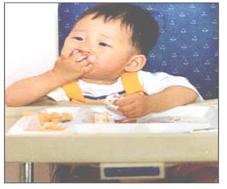
사진 4-124. 이유식을 손으로 먹도록 한다.
Copyright ⓒ 2011 John Sangwon Lee, MD, FAAP
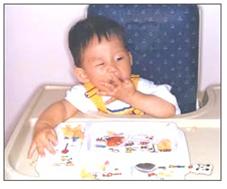
사진 4-125. 이유식을 손으로 먹도록 한다.
Copyright ⓒ 2011 John Sangwon Lee, MD, FAAP
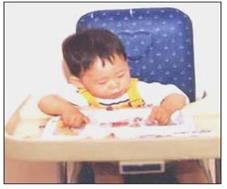
사진 4-126. 이유식을 손으로 먹도록 한다.
Copyright ⓒ 2011 John Sangwon Lee, MD, FAAP
| 이유식을 줄 때 주의할 점 |
What to look for in solid food feedings
1. 한 번에 너무 많이 이유식을 먹이지 않는다.
- 이유식을 처음 먹이기 시작할 때는 한꺼번에 너무 많은 양을 먹여서는 안 된다.
- 예를 들어 4~6개월 된 영아가 한 번에 60g의 이유식을 먹었다고 가정하자.
- 생후 4~6개월 된 영아의 체중은 출생 시 체중의 배가 되는 것이 보통이다.
- 이 아이의 출생 시 체중이 3.5㎏이었다면 생후 4~6개월이 될 때의 체중은 출생 시 체중의 배가 되는 7㎏ 정도 될 것이다.
- 체중이 7kg인 생후 4~6개월의 영아가 한 번에 먹은 60g의 이유식의 양은 체중 70㎏ 되는 성인이 600g 의 이유식을 한 번에 먹는 것과 거의 같은 양이다.
- 60g의 이유식은 한명의 성인이 한 번 먹는 양으로서는 그렇게 많지 않은 양지만 4~6개월 된 영아가 한 번에 먹기에는 상당히 많은 이유식 양이다. 이론적으로는 이러하다.
- 소아청소년과에서 이유하는 영아들을 보다보면 많은 부모들이 이유할 때 이유식을 한 번에 너무 많이 먹이는 것을 본다.
- 이유식을 너무 많이 먹는 영아들의 일부는 이유식을 너무 많이 먹어서 더 건강하게 성장 발육하기보다 여러 가지 병에 더 자주 걸릴 수 있다. 이유식을 한꺼번에 너무 많이 먹이면 소화 장애가 생기기 쉽고 비만증에 걸릴 기 쉽다. 어릴 때 비만한 영유아들은 성인이 된 이후에도 비만한 성인이 될 가능성이 더 많다.
- 한 종류의 이유식을 시험 삼아 조금씩 1주간 먹여보고 아기에게 알맞은 이유식의 종류와 양을 알아내야 한다.
2. 이유식을 억지로 먹이지 않는다.
- 먹고 싶은 이유식을 아기에게 수저로 떠먹일 때 아기는 입을 벌리고 턱을 앞으로 내밀며 열심히 받아먹는다.
- 반면, 먹기 싫으면 고개를 좌우로 돌린다. 때로는 목을 뒤로 젖히기도 한다. 아기가 먹기 싫어하는 이유식은 억지로 먹여서는 안 된다.
- 그 이유식에 불내증이 있던지 또 알레르기를 일으키는 이유식은 받아먹지 않는다. 때로는 입을 벌리지 않는다. 먹고 난 후 바로 토한다.
3. 골고루 이유식을 먹인다.
- 생후 6~9개월 이후 영아들은 자기들이 좋아하는 이유식과 싫어하는 이유식을 분별해서 먹을 줄 안다.
- 곡물류(곡분류) 이유식, 고기류 이유식, 채소류 이유식 등 여러 가지 이유식을 선택해서 먹인다. 따라서 영아들의 식성에 따라 좋아하는 이유식을 골고루 선택해서 먹여야 한다.
4. 이유식을 상하지 않게 보관한다.
- 이유식을 사서 먹일 때, 캔이나 포장박스 속에서 꺼낸 후 먹이다 남은 이유식은 세균에 더 쉽게 오염되거나 상하기 쉽다. 남은 이유식은 버리거나 곧장 냉장고 속에 잘 보관해야 한다.
5. 이유식 성분을 정확히 확인한다.
- 이유식을 사서 먹일 때, 포장박스 속에 넣은 이유식이나 캔 속에 넣은 이유식을 먹일 때는 이유식 포장박스나 캔 이유식에 적혀 있는 이유식의 성분을 잘 읽은 후 먹여야 한다.
6. 이유식을 먹일 때나, 먹인 후 아기의 반응을 잘 관찰한다.
- 어떤 성분, 어떤 종류의 이유식을 먹기 싫어하거나 그 이유식을 먹은 후 경미하게 구토나 설사를 할 때는 그 이유식을 며칠 내지 몇 주 동안 먹이지 말고 관찰했다가 또 다시 먹여 볼 수 있다.
- 알레르기 반응, 음식물 불 내증, 상한 이유식, 첨가 화학물질로 인한 부작용들을 생각해 본다,
7. 부모가 이유식을 먼저 먹어 본다.
- 영유아에게 이유식을 먹이기 전에 먼저 부모가 영유아용 이유식을 맛보고 먹여야 한다.
- 부모들에게 맛이 없는 이유식은 아기에게도 맛이 없는 이유식일 수 있다.
- 이유식이 상해 있나 알아본다.
8. 이유식에서 첫 돌 이전 영아들에게 먹여서는 안 되는 음식물 재료는 뺀다.
- 달걀, 초콜릿, 우유 등은 알레르기성 질환을 잘 일으키는 음식물이다. 특히 부모 형제자매들이 알레르기성 질환을 가진 가족 병력이나 과거 병력이 있으면 의사의 지시가 없이 생후 12개월까지 전 우유와 달걀흰자는 먹이지 않는다.
- 단, 달걀노른자는 생후 6개월부터 먹일 수 있다. 저자는 가능하면 달걀노른자도 첫돌 이후 먹이는 것을 권장 한다.
- 시금치, 비트, 순무, 당근, 콜랄 등으로 만든 음식물도 첫 돌의 이전 영아들의 이유식으로서도 부적절하므로 먹이지 않는다.
- 음식물 부패 방지 화학물질, 음식물 색 내는 화학물질, 음식물 맛나게 하는 화학물질이 든 영아 음식물은 먹이지 않는다.
9 영아들에게 이유식만 또는 전 우유만 먹이지 않는다.
- 아기들에게 이유식만 먹이거나 전 우유만 먹여서 안 된다.
- 그 이유식 성분이나 전우유(전유/Whole milk)의 성분이 젖이나 인공영양을 먹는 영아들의 성장 발육에 적절치 않다.
- 어떤 이유식에는 당질이 너무 많이 들어 있을 수 있다. 또, 염분이 너무 많이 들어있거나 염분이 너무 적게 들어 있을 수 있다.
- 모유 대신 전 우유를 먹을 때 전 우유의 성분 자체가 영아들의 성장발육에 적절치 않을 뿐만 아니라, 전 우유를 많이 섭취하면 다른 종류의 이유식을 먹을 여유가 없다. 그래서 균형 잡힌 이유식을 먹일 수 없다.
- 전 우유의 성분에는 철분 함량이 낮 다. 전 우유만 많이 먹으면 다른 음식물을 균형 잡히게 먹지 못해 아기에게 철 결핍성 빈혈이 생길 수 있다.
- 적어도 생후 12개월까지 전 우유를 먹이는 대신 모유나 인공영양을 먹여야 한다.
- 영아들이 여러 종류의 이유식과 집안 식구들이 먹는 밥상 음식물을 잘 먹고 잘 소화시키고 잘 성장발육 할 수 있으면 첫 돌이 지난 이후부터 전 우유를 컵으로 먹이기 시작한다.
- 생우유는 어느 연령층에 있는 아이들이나 성인들이든 먹어서는 안 된다.
10. 이유식을 먹을 때는 가끔 맹물(식수)을 먹인다.
- 젖이나 인공영양 속에 든 수분의 양은 영아들의 생리에 가장 알맞다. 반면, 이유식 속에 든 수분의 양은 영아들의 생리에 적합하지 않을 수 있다.
영아들이 이유식을 먹은 후에는 갈증이 나는지 안 나는지 확실히 알기가 어렵다. 따라서 매일 맹물을 컵으로 가끔 먹여 본다. 맹물보다 주스류 이유식이나 소다수 등을 많이 먹이면 더 갈증이 날 수 있다. 너무 짜거나 너무 단 이유식을 먹었을 때는 섭취한 염분이나 당질의 양에 비례하여 맹물을 더 먹어야 한다.
11. 이유식을 우유병에 넣어서 먹이지 않는다.
- 이유식을 스푼으로 먹일 때 어떤 영아들은 이유식을 안 받아먹을 수 있다. 그렇다고 우유병 꼭지 구멍을 보통 크기보다 훨씬 더 크게 뚫어 이유식을 우유병으로 먹이거나 이유식과 인공영양을 섞어 우유병으로 먹여서는 안 된다.
- 이런 식으로 이유식을 우유병에 넣어서 영아들에게 먹이면 크게 뚫린 우유병 꼭지의 구멍을 통해서 이유식이 한꺼번에 왈칵 나와 아기가 사레들리거나 이유식이 기도 속으로 흡인될 수 있다. 또, 우유병에 든 이유식이 우유병 꼭지 구멍을 막아 빨아먹기가 곤란할 수 있다.
- 따라서 시리얼류 이유식이나 다른 액체의 이유식은 가능한 한 수저로 먹여야 한다.
12. 이유식을 먹일 때도 될 수 있으면 아기를 포근히 안고 먹인다.
- 엄마가 영아에게 이유식을 먹일 때도 젖을 먹일 때처럼 아기를 엄마의 품에 포근히 안고 먹이든지, 영아용 의자 위에 앉힌 다음 엄마가 따뜻한 눈길 접촉 사랑을 하면서 먹여야 한다.
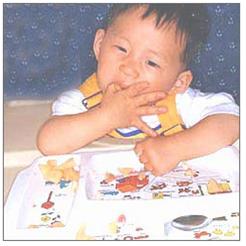
사진 4-127. 이유식을 먹일 때는 아기를 포근히 안아주고 수저로 떠먹이거나 아기 스스로 수저나 손, 혹은 훈련용 컵으로 먹게 한다.
Copyright ⓒ 2011 John Sangwon Lee, MD, FAAP
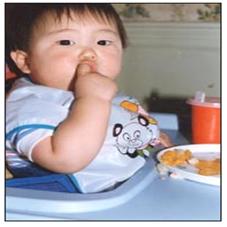
사진 4-128. 이유식은 자신이 손이나 수저로 먹도록 한다.
Copyright ⓒ 2011 John Sangwon Lee, MD, FAAP

사진 4-129. 이유식은 자신이 손이나 수저로 먹도록 한다.
Copyright ⓒ 2011 John Sangwon Lee, MD, FAAP
| 집에서 만든 이유식 |
Homemade solid foods
- 실증되고 신선한 채소, 과일, 고기, 곡물 등 이유식 재료로 이유식을 부모가 집에서 직접 만들어 영유아들에게 먹이는 것도 좋은 방법이다.
- 집에서 이유식을 부모가 요리해서 먹이면 이유식의 성분이 무엇인지를 정확히 알 수 있기 때문에 안심하고 영아 자녀에게 먹일 수 있다.
- 집에서 만든 이유식의 값은 싸고 한결 신선하다는 장점도 있다.
- 시장에서 직접 영양가가 풍부한 재료를 사다가, 깨끗이 씻고 믹서로 갈고 체로 거르고 칼로 썰고 다져 만든 이유식이니, 맛과 정성은 말로 다 할 수 없다.
- 이유식을 집에서 만들 때는 너무 짜거나 달게 만들어서는 안 된다.
- 화학조미료나 음식물 첨가 색소도 넣지 않고 음식물 방부제도 넣지 않고 엄마아빠의 사랑손길로 요리 한다.
- 각종 영양분이 골고루 든 균형 잡인 이유식을 만들어 먹이는 것이 무엇보다 중요하다.
- 또, 가능하면 아기의 나이, 체질, 음식물 섭취 습성에 맞게 요리해 먹여야 한다. 지나치게 많은 양을 먹여서도 안 된다. 또, 이유식이 상하지 않게 주의해야 한다.
- 이유식을 먹이면 모유의 분비량이 자연적으로 감소될 수 있다. 이 때문에 예기치 않게 일찍 이유를 할 수 있다.
- 이유식을 너무 많이 먹일 때 소아 비만증이 생길 수 있다.
- 집에서 요리한 음식물이든, 사서 먹는 이유식이든 음식물 알레르기, 이유식 불내증, 소화불량 등의 문제들이 생길 수 있다.
- 집에서 이유식을 만들어 먹일 때도 생후 6개월 이전 영아들에게는 과일, 과일주스, 채소 같은 음식물 재료로 만든 과일류 이유식이나 채소류 이유식을 먹여서는 안 된다.
- 생후 6개월이 지난 이후 영아들에게도 과일류 이유식, 과일주스류 이유식, 채소류 이유식 등을 많이 먹여서는 안 된다.
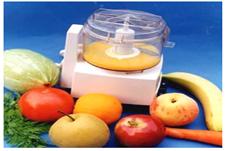
사진 4-130. 집에서 신선한 이유식 재료로 이유식을 만들어 먹일 수 있다
Copyright ⓒ 2011 John Sangwon Lee, MD, FAAP
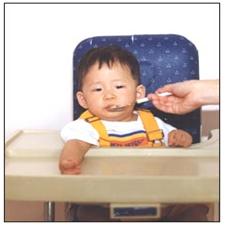
사진 4-131. 4~6개월 이후부터 이유식을 조심히 먹일 수 있다.
Copyright ⓒ 2011 John Sangwon Lee, MD, FAAP
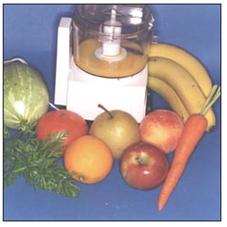
사진 4-132. 생후 6개월 이전 영아들에게 과일이나 과일류 주스나 채소로 만든 채소류 이유식을 먹여서는 안 된다.
Copyright ⓒ 2011 John Sangwon Lee, MD., FAAP
Solid food and How to feed the solid foods 이유식과 이유식을 잘 먹이는 방법
Feeding newborns with breast milk or artificial nutrition cannot be given uniformly, like drawing a picture.
Each one is medical art and dietary medicine.
The same is true of feeding infants with baby food. The method of feeding baby food to infants cannot be uniformly determined.
The following information can be used as a reference when feeding baby food.
1. Weaning method according to the type of baby food
- Thrust reflex disappears after 4 months of age.
- When giving baby food to infants after 4 months of age for the first time, it is better to mix the baby food with salty breast milk or artificial nutrition and feed it with a spoon.
- If infants receive baby food well and digest it well, they can start giving baby food from then on. The first baby food that can be fed as a test is cereal type baby food, that is, cereal type baby food made from rice.
- You can get enough energy, nutrients, vitamins, iron, and other minerals that infants need from cereal baby food made from rice. In particular, it is considered one of the good baby foods because it does not contain glutin in the ingredients of rice cereals for infants that have already been cooked.
- At first, a spoon (5-15g) of cereal baby food made with rice is squeezed in breast milk, artificial nutrition, or water and fed 1-3 times a day.
- Try feeding cereal baby foods made with rice like this one to four times a day, for three to seven days. Observe whether you eat the baby food well, whether you can digest it well after eating the baby food, whether you do not fart a lot, and whether you have gastrointestinal disorders such as diarrhea or constipation.
- As a result of observing carefully what side effects occur after eating baby food made of rice, if there is no problem and the baby likes to eat the baby food, the amount of the baby food is gradually increased and fed.
- Then, choose one of vegetable-based baby foods cooked with carrots, spinach, and pumpkin, or fruit-based baby foods made with bananas and apples.
- However, fruit food or vegetable food should not be fed to infants older than 6 months of age as much as possible.
- Fruit juices or vegetable juices should not be fed before 6 months of age, and as much as possible to infants after that.
- Next, start feeding one of the pureed vegetable baby food, pureed fruit baby food, and pureed meat baby food. Also, try mixed baby food, whether it is cereal baby food and fruit baby food. From this point, you can also feed teasing biscuits (see photos 5-73, 5-74).
- Then, you can feed one, two or three baby foods from a variety of baby foods such as cereal baby food, vegetable baby food, fruit baby food, and meat baby food. Meat baby foods such as beef, lamb, chicken, fish, meat, etc. should be tested one by one from 9 to 10 months of age. If infants like to eat and digest well, continue feeding them according to the doctor’s instructions. Eat meat baby food and fish baby food with the same tips as when feeding cereal baby food.

Photo 4-115. Practice cup for feeding baby food Copyright ⓒ 2011 John Sangwon Lee, MD, FAAP

Photo 4-116. Depending on the age, baby food snacks can also be given to eat by hand. Copyright ⓒ 2011 John Sangwon Lee, MD, FAAP

Photo 4-117. Depending on the age, you can give baby baby food snacks to be held and eaten by yourself. Copyright ⓒ 2011 John Sangwon Lee, MD, FAAP
2. How to reason according to the baby’s age (monthly age)
When you first start feeding solid baby food to infants aged 6 to 8 months, you can breastfeed three times a day for the first time for the first time, and then feed one or two tablespoons of solid baby food as a test immediately. Some infants eat almost half a cup of baby food a day.
However, even at this time, breast milk becomes the main energy source and nutrients for most infants. As infants eat more and more baby food, the amount or frequency of milk they eat per day decreases.
It can even reduce the breast size of a nursing mother.
Most of the 8-10 months old infants like to eat meals at the table. Infants of this age can be fed baby food 3-4 times a day in addition to breast milk, and high protein baby foods such as meat baby food, chicken baby food, bean baby food, cheese baby food, tofu baby food, and peanut butter baby food can be fed. You can feed cereal baby food 2-3 times a day, about half a cup at a time, and feed rice, rice porridge, or bread.
And fruit baby food or vegetable baby food at a time 5 ~ 30cc can be fed 4 times a day. Fruit juice baby food is fed about 90cc once a day.
High protein foods such as meat, chicken, fish, cheese, beans, or peanut butter are fed about once a day. After 9 months of age, egg yolk is fed 3-4 times a week. If you eat solid baby food well, you can feed the solid baby food first and breastfeed later. At this time, there are babies who feed on breast milk from time to time to receive their mother’s love, rather than to obtain energy or nutrients by feeding their mother’s breast milk.
Infants aged 10-12 months eat food from the table quite well. In general, it is recommended not to feed whole milk until the first birthday, but after the first birthday, infants and toddlers who eat little or no breast milk can start feeding whole milk. It is not recommended to feed low-fat skim milk or evaporated milk. If infants are allergic to milk, artificial nutrition made with soy protein or low allergic artificial nutrition is fed.
However, it can also cause allergies, so be careful. Cheese or tofu contains a lot of calcium, so it is a good food to feed infants.
When taking a nap during this time, you can love your baby comfortably and happily, and you can breastfeed after eating breakfast and lunch.
As the intake of solid baby food increases, the meal begins to eat at the table, and the number and amount of breastfeeding naturally decreases gradually, if it is determined that the mother’s milk is growing well even if she is no longer feeding, she can either completely milk or breastfeed. There are some reasons why artificial nutrition can be fed on an as-needed basis.
When feeding solid baby food for the first time, try one type of solid baby food as a test and feed it for about a week.
If you eat that solid food and do not have problems such as gastrointestinal disorders and allergies, you can feed a comprehensive baby food mixture of two or three solid baby foods.
If infants eat the two solid baby foods and digest them well, they can feed them 1 to 4 times a day.
The amount of solid baby food is also gradually increased with growth rate and weight gain.
The amount of solid baby food that can be fed at one time depends on the amount of breast milk or artificial nutrition the infant eats, and the infant’s diet. However, it is better to start feeding the solid baby food little by little than to feed it too much at once, and to feed more gradually.
In other words, it is much better to start feeding a small amount of solid baby food rather than feeding a lot from the beginning and gradually increase the amount. Juice When giving solid baby food for the first time, try feeding 15-30cc of one type of juice at a time. When giving cereal solid baby food or meat baby food for the first time, give it about a tablespoon (15㏄).
The timing of giving solid foods can be decided by the mother. Whether to give a solid feed immediately after feeding breast milk or artificial nutrition, only to give a solid feed at the time of feeding breast milk or artificial nutrition, feed the solid feed just before breast milk or artificial nutrition, or between the time to eat breast milk or artificial nutrition.
Can give to Infants before 6-8 months of age may be fed breast milk or artificial nutrition first, followed by solid baby food.
On the other hand, when giving solid baby food to infants after 6-8 months, they can be fed 1-4 times a day, just before or immediately after feeding breast milk or artificial nutrition.
You may choose one of these two methods of feeding solid baby food, or you may feed the two together.

Photo 4-118.There are many infants who eat well the meals their family members eat within 10 months of age. Copyright ⓒ 2011 John Sangwon Lee, MD, FAAP

Photo 4-119. When feeding solid baby food, hold it softly, love it, and feed it with a spoon. Copyright ⓒ 2011 John Sangwon Lee, MD, FAAP

Photo 4-120. Feed solid baby food with a spoon. Copyright ⓒ 2011 John Sangwon Lee, MD, FAAP

Photo 4-121. Depending on the type of liquid baby food, it is fed with a cup and spoon. Copyright ⓒ 2011 John Sangwon Lee, MD, FAAP

Photo 4-122. Liquid baby food is fed with a cup or spoon. Copyright ⓒ 2011 John Sangwon Lee, MD, FAAP

Photo 4-123. Eat baby food with your hands. Copyright ⓒ 2011 John Sangwon Lee, MD, FAAP

Photo 4-124. Eat baby food with your hands. Copyright ⓒ 2011 John Sangwon Lee, MD, FAAP

Photo 4-125. Eat baby food with your hands. Copyright ⓒ 2011 John Sangwon Lee, MD, FAAP

Photo 4-126. Eat baby food with your hands. Copyright ⓒ 2011 John Sangwon Lee, MD, FAAP
Points to note when giving baby food, What to look for in solid food feedings
- Don’t feed too much baby food at once.
- When you first start feeding baby food, don’t eat too much at once.
- For example, suppose a 4-6 month old infant ate 60 grams of baby food at a time.
- The weight of infants aged 4-6 months after birth is usually twice that of the birth weight. If the child’s birth weight was 3.5 kg, the weight at the age of 4-6 months would be about 7 kg, which is twice the weight at birth.
- The amount of 60g of baby food consumed by 4-6 months old infants weighing 7kg at a time is almost the same as that of an adult weighing 70kg eat 600g of baby food at a time. 60g of baby food is not that much for an adult to eat at a time, but it is quite a lot of baby food for a 4-6 month old infant to eat at a time. In theory, it is like this.
- When looking at infants weaning in the Department of Pediatrics and Adolescents, we see that many parents feed too much baby food at once when weaning.
- Some of the infants who eat too much baby food can get a lot of diseases more often than they grow and develop healthier because they eat too much baby food.
- If you eat too much baby food at the same time, you are prone to digestive problems and prone to obesity.
- Infants and toddlers who are obese when they are young are more likely to become obese adults after they become adults.
- You should try one type of baby food as a test, feed it little by little for 1 week, and find out the type and amount of baby food suitable for your baby.
2. Do not force baby food.
- When feeding the baby food that they want to eat with a spoon, the baby opens his mouth and puts his chin forward, and eats it eagerly.
- On the other hand, if you don’t want to eat, turn your head to the left or right. Sometimes the neck is tilted back.
- Baby food that the baby does not like to eat should not be forced to feed. We do not accept baby foods that are intolerant to the baby food or cause allergies. Sometimes they don’t open their mouths.
- Vomit immediately after eating.
3. Feed the baby food evenly.
- After 6 to 9 months of age, infants know how to discern and eat baby foods they like and don’t like. Select and feed various baby foods such as cereals (grain classification) baby food, meat baby food, and vegetable baby food. Therefore, you should choose and feed your favorite baby food evenly according to the diet of infants.
4. Store baby food so that it does not spoil.
- When buying and feeding baby food, the remaining baby food after taking it out of the can or packaging box is more susceptible to contamination or spoilage by bacteria.
- Throw away any remaining baby food or keep it in the refrigerator immediately.
5. Confirm the ingredients of baby food accurately.
- When buying and feeding baby food, when feeding baby food in a packaging box or in a can, you should carefully read the ingredients of the baby food on the packaging box or canned baby food before feeding.
6. Observe the baby’s reaction when feeding baby food or after feeding.
- If you do not like to eat certain ingredients or types of baby food, or if you have mild vomiting or diarrhea after eating the baby food, you can observe the baby food without feeding it for a few days to several weeks, then try again.
- Think about the side effects of allergic reactions, food intolerance, bad baby food, and added chemicals.
7. Parents try baby food first.
- Before feeding baby food to infants, parents must first taste and feed baby food for infants and toddlers.
- Baby food that doesn’t taste good for parents can be baby food that doesn’t taste good for babies.
- Find out if the baby’s food is injured.
8. Subtract food ingredients that should not be fed to infants before the first birthday from baby food.
- Eggs, chocolate, and milk are foods that cause allergic diseases. In particular, if parents and siblings have a family history or past medical history with allergic diseases, milk and egg whites are not fed until 12 months of age without a doctor’s instructions.
- However, egg yolk can be fed from 6 months of age. The author recommends feeding egg yolks after the first stone if possible.
- Foods made with spinach, beets, turnips, carrots, and cola are also inappropriate as baby food for infants before their first birthday, so don’t feed them.
- Do not feed infants with food spoilage chemicals, food coloring chemicals, or food flavoring chemicals.
9 Do not feed infants only baby food or whole milk.
- Babies should not be fed only baby food or whole milk.
- The ingredients of baby food or whole milk (whole milk) are not suitable for the growth and development of infants who eat milk or artificial nutrition. Some baby foods may contain too much sugar.
- Also, it may contain too much salt or too little salt. When eating whole milk instead of breast milk, the ingredients of the whole milk itself are not suitable for the growth and development of infants, and if you consume a lot of whole milk, you cannot afford to eat other types of baby food. So you cannot feed balanced baby food.
- Whole milk has a low iron content. If you eat a lot of whole milk, you can’t eat other foods in a balanced way, which can lead to iron deficiency anemia in your baby. Instead of feeding the whole milk until at least 12 months old, breast milk or artificial nutrition should be fed.
- If infants are able to eat well, digest and grow well with various types of baby food and meals that family members eat, they start feeding the whole milk in a cup after the first birthday. Raw milk should not be eaten by children or adults of any age.
- When eating baby food, sometimes feed plain water (drinking water). The amount of water in breast milk or artificial nutrition is most suitable for the physiology of infants.
- On the other hand, the amount of water in baby food may not be suitable for the physiology of infants. It is difficult to know for sure whether infants are thirsty after eating baby food.
10. Therefore, I try to drink fresh water every day with a cup.
- If you feed more juice-based baby food or soda water than plain water, you may be thirsty. When eating too salty or too sweet baby food, you should eat more plain water in proportion to the amount of salt or sugar consumed.
11. Do not put baby food in a milk bottle.
- When feeding baby food with a spoon, some infants may not eat it. However, you should not feed baby food with a milk bottle or mix baby food with artificial nutrients and feed it with a milk bottle by making the top hole of the milk bottle much larger than the normal size.
- In this way, if you put baby food into a milk bottle and feed it to infants, the baby food can come out all at once through the hole in the big open milk bottle, and the baby can be sucked into the airways.
- In addition, the baby food in the milk bottle can block the hole in the top of the milk bottle, making it difficult to suck up. Therefore, cereal baby food or other liquid baby food should be fed with a spoon as much as possible.
12.When feeding baby food, if possible, hold the baby warmly and feed it.
When a mother feeds baby food to her infant, she should either hold the baby snugly in her mother’s arms as when feeding her breasts or sit on her infant’s chair and then feed her mother with her warm eye contact love.

Photo 4-127. When feeding baby food, hold the baby warmly and feed it with a spoon, or let the baby eat it with a spoon, hand, or training cup. Copyright ⓒ 2011 John Sangwon Lee, MD, FAAP

Photo 4-128. You can eat baby food with your own hands or spoon. Copyright ⓒ 2011 John Sangwon Lee, MD, FAAP

Photo 4-129. You can eat baby food with your own hands or spoon. Copyright ⓒ 2011 John Sangwon Lee, MD, FAAP
Homemade baby food( Solid)
Homemade solid foods It is also a good way to make baby food at home by parents using proven and fresh ingredients for baby food such as vegetables, fruits, meat, and grains, and feed them to infants and toddlers.
If you cook and feed baby food at home, you can know exactly what ingredients are in the baby food, so you can feed it to your infant with confidence.
The advantage of homemade baby food is that it is cheap and fresh.
This is a baby food made by buying nutritious ingredients directly from the market, washing them thoroughly, grinding with a mixer, sifting, chopping and chopping with a knife.
When making baby food at home, don’t make it too salty or sweet. It does not contain chemical seasonings, food additives, food preservatives, and cooks with mom and dad’s love. It is most important to make and feed a balanced baby food with various nutrients evenly.
In addition, if possible, the baby’s age, constitution, and eating habits should be cooked and fed.
Don’t eat too much. Also, be careful not to spoil the baby food.
Feeding baby food can naturally reduce the amount of milk produced. Because of this, you can reason unexpectedly early. Eating too much baby food can lead to childhood obesity.
Whether it’s home-cooked food or purchased baby food, problems such as food allergies, baby food intolerance, and indigestion can occur.
Even when making baby food at home, infants older than 6 months of age should not be fed fruit or vegetable baby food made with food ingredients such as fruits, fruit juice, and vegetables.
After 6 months of age, infants should not be fed a lot of fruit type baby food, fruit juice type baby food, and vegetable type baby food.

Photo 4-130.You can make baby food with fresh baby food ingredients at home and feed it. Copyright ⓒ 2011 John Sangwon Lee, MD, FAAP

Photo 4-131. You can feed baby food carefully after 4-6 months. Copyright ⓒ 2011 John Sangwon Lee, MD, FAAP

Photo 4-132. Infants older than 6 months of age should not be fed fruit or fruit juices or vegetable baby foods made from vegetables. Copyright ⓒ 2011 John Sangwon Lee, MD., FAAP
출처 및 참조 문헌
- www.drleepediatrics.com 제1권 소아청소년 응급 의료
- www.drleepediatrics.com 제2권 소아청소년 예방
- www.drleepediatrics.com 제3권 소아청소년 성장 발육 육아
- www.drleepediatrics.com 제4권 모유,모유수유, 이유
- www.drleepediatrics.com 제5권 인공영양, 우유, 이유식, 비타민, 미네랄, 단백질, 탄수화물, 지방
- www.drleepediatrics.com 제6권 신생아 성장 발육 육아 질병
- www.drleepediatrics.com제7권 소아청소년 감염병
- www.drleepediatrics.com제8권 소아청소년 호흡기 질환
- www.drleepediatrics.com제9권 소아청소년 소화기 질환
- www.drleepediatrics.com제10권. 소아청소년 신장 비뇨 생식기 질환
- www.drleepediatrics.com제11권. 소아청소년 심장 혈관계 질환
- www.drleepediatrics.com제12권. 소아청소년 신경 정신 질환, 행동 수면 문제
- www.drleepediatrics.com제13권. 소아청소년 혈액, 림프, 종양 질환
- www.drleepediatrics.com제14권. 소아청소년 내분비, 유전, 염색체, 대사, 희귀병
- www.drleepediatrics.com제15권. 소아청소년 알레르기, 자가 면역질환
- www.drleepediatrics.com제16권. 소아청소년 정형외과 질환
- www.drleepediatrics.com제17권. 소아청소년 피부 질환
- www.drleepediatrics.com제18권. 소아청소년 이비인후(귀 코 인두 후두) 질환
- www.drleepediatrics.com제19권. 소아청소년 안과 (눈)질환
- www.drleepediatrics.com 제20권 소아청소년 이 (치아)질환
- www.drleepediatrics.com 제21권 소아청소년 가정 학교 간호
- www.drleepediatrics.com 제22권 아들 딸 이렇게 사랑해 키우세요
- www.drleepediatrics.com 제23권 사춘기 아이들의 성장 발육 질병
- www.drleepediatrics.com 제24권 소아청소년 성교육
- www.drleepediatrics.com 제25권 임신, 분만, 출산, 신생아 돌보기
- Red book 29th-31st edition 2021
- Nelson Text Book of Pediatrics 19th- 21st Edition
- The Johns Hopkins Hospital, The Harriet Lane Handbook, 22nd edition
- 응급환자관리 정담미디어
-
소아가정간호백과–부모도 반의사가 되어야 한다, 이상원
-
Neonatal Resuscitation American heart Association
-
Neonatology Jeffrey J.Pomerance, C. Joan Richardson
-
Pediatric Resuscitation Pediatric Clinics of North America, Stephen M. Schexnayder, M.D.
-
Pediatric Critical Care, Pediatric Clinics of North America, James P. Orlowski, M.D.
-
Preparation for Birth. Beverly Savage and Dianna Smith
-
Infectious disease of children, Saul Krugman, Samuel L Katz, Ann A. Gershon, Catherine Wilfert
- Pediatric Nutritional Handbook American Academy of Pediatrics
- 소아가정간호백과–부모도 반의사가 되어야 한다, 이상원
- The pregnancy Bible. By Joan stone, MD. Keith Eddleman, MD
- Neonatology Jeffrey J. Pomerance, C. Joan Richardson
- Preparation for Birth. Beverly Savage and Dianna Smith
- 임신에서 신생아 돌보기까지. 이상원
- Breastfeeding by Ruth Lawrence and Robert Lawrence
- Infectious disease of children, Saul Krugman, Samuel L Katz, Ann A. Gershon, Catherine Wilfert
- The Harriet Lane Handbook 19th Edition
- 제4권 모유, 모유수유, 이유 참조문헌 및 출처
- 제5권 인공영양, 우유, 이유, 비타민, 단백질, 지방 탄수 화물 참조문헌 및 출처
- 제6권 신생아 성장발육 양호 질병 참조문헌 및 출처
- 소아과학 대한교과서
- 그 외
|
Reviewed 3/2015 Copyright ⓒ 2015 John Sangwon Lee, MD, FAAP 미국 소아과 전문의, 한국 소아청소년과 전문의 이상원 저 “부모도 반의사가 되어야 한다”-내용은 여러분들의 의사로부터 얻은 정보와 진료를 대신할 수 없습니다. “The information contained in this publication should not be used as a substitute for the medical care and advice of your doctor. There may be variations in treatment that your doctor may recommend based on individual facts and circumstances. “Parental education is the best medicine.” |